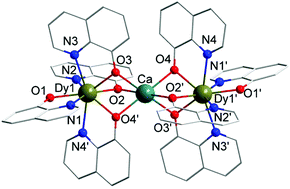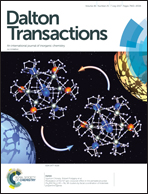Strictly linear trinuclear Dy–Ca/Mg–Dy single-molecule magnets: the impact of long-range f–f ferromagnetic interactions on suppressing quantum tunnelling of magnetization leading to slow magnetic relaxation†
Abstract
The synthesis, structural characterization and magnetic properties of four heterometallic complexes with formulas Ln2M(OQ)8 [Ln(III) = Dy, M(II) = Ca (1), Mg (2); Ln(III) = Er, M(II) = Ca (3), Mg (4); HOQ = 8-hydroxyquinoline] are reported. Complexes display a perfectly linear arrangement of three metal ions involving two terminal Ln(III) ions and one central alkaline earth M(II) ion, and they are bridged by three phenolato oxygen atoms from three 8-hydroxyquinoline ligands. Direct-current (dc) magnetic susceptibility studies show that there exists a long-range ferromagnetic (FM) interaction between two f-electronic centers in Dy-based complexes 1 and 2 albeit they are separated by diamagnetic alkaline earth ions, and the FM interaction has been successfully reproduced by ab initio calculations. Alternating current (ac) magnetic susceptibility measurements indicate that complexes 1 and 2 exhibit significant single-molecule magnet (SMM) behaviors. This is mostly attributed to the parallel magnetic axes of individual Dy(III) sites aligning closely to the Dy–M–Dy direction, and the linearly extending magnetic susceptibility tensors of each ion lead to the FM interaction. The dc and ac susceptibility studies of the intramolecularly diluted complexes reveal that the f–f coupling suppresses the QTMs significantly in the absence of the external magnetic field.



 Please wait while we load your content...
Please wait while we load your content...